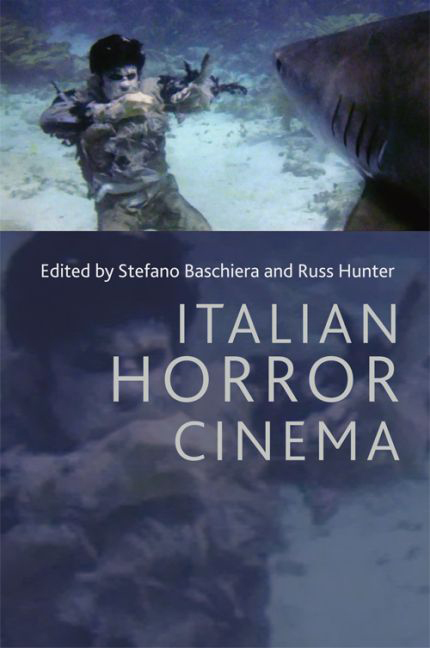Book contents
- Frontmatter
- Contents
- List of figures
- List of contributors
- Acknowledgements
- Introduction
- 1 Preferisco l'inferno: early Italian horror cinema
- 2 Domestic films made for export: modes of production of the 1960s Italian horror film
- 3 The 1980s Italian horror cinema of imitation: the good, the ugly and the sequel
- 4 Knowing the unknown beyond: ‘Italianate’ and ‘Italian’ horror cinema in the twenty-first century
- 5 Bavaesque: the making of Mario Bava as Italian horror auteur
- 6 The Argento Syndrome: aesthetics of horror
- 7 Scrap metal, stains, clogged drains: Argento's refuse and its refusals
- 8 The giallo /slasher landscape: Ecologia del delitto, Friday the 13th and subtractive spectatorship
- 9 Kings of terror, geniuses of crime: giallo cinema and fumetti neri
- 10 Political memory in the Italian hinterland: locating the ‘rural giallo’
- 11 The horror of progressive rock: Goblin and horror soundtracks
- 12 ‘The only monsters here are the filmmakers’: animal cruelty and death in Italian cannibal films
- 13 Italian horror cinema and Italian film journals of the 1970s
- Index
9 - Kings of terror, geniuses of crime: giallo cinema and fumetti neri
Published online by Cambridge University Press: 12 September 2017
- Frontmatter
- Contents
- List of figures
- List of contributors
- Acknowledgements
- Introduction
- 1 Preferisco l'inferno: early Italian horror cinema
- 2 Domestic films made for export: modes of production of the 1960s Italian horror film
- 3 The 1980s Italian horror cinema of imitation: the good, the ugly and the sequel
- 4 Knowing the unknown beyond: ‘Italianate’ and ‘Italian’ horror cinema in the twenty-first century
- 5 Bavaesque: the making of Mario Bava as Italian horror auteur
- 6 The Argento Syndrome: aesthetics of horror
- 7 Scrap metal, stains, clogged drains: Argento's refuse and its refusals
- 8 The giallo /slasher landscape: Ecologia del delitto, Friday the 13th and subtractive spectatorship
- 9 Kings of terror, geniuses of crime: giallo cinema and fumetti neri
- 10 Political memory in the Italian hinterland: locating the ‘rural giallo’
- 11 The horror of progressive rock: Goblin and horror soundtracks
- 12 ‘The only monsters here are the filmmakers’: animal cruelty and death in Italian cannibal films
- 13 Italian horror cinema and Italian film journals of the 1970s
- Index
Summary
Italians first of all fear sudden and violent death … The world of vice also demands its daily victims. Street-walkers are found dead with silk stockings wound tight around their necks or knives stuck in their ribs, on their unmade beds or in country lanes … (Luigi Barzini, The Italians, 1968: 107)
IL GIALLO A FUMETTI
Any attempt to nominate this or that film as the ‘first’ giallo has to negotiate the question of which version of this notoriously slippery term is being used – the giallo in its more inclusive Italian sense, ‘a metonym for the entire mystery genre’ (Koven, 2006: 2), or as a more particular B-movie filone that surfaced intermittently in the 1960s, blossomed more fully in the early to mid-1970s and has continued to appear sporadically, particularly in the films of Dario Argento. Either way, Mario Bava's La ragazza che sapeva troppo / The Girl Who Knew Too Much (Italy, 1962; refashioned as The Evil Eye, 1964) and particularly Sei donne per l'assassino/Blood and Black Lace (a coproduction involving Italy/West Germany/France, 1964) are often accorded seminal status in teleological accounts of the giallo as a cinematic cycle. Both have at various times had the distinction of being identified as the first ‘proper’ giallo ; the former with its tourist-eyewitness heroine and the latter with its bodycount narrative, eroticised violence and overheated visual stylisation. However, neither film clearly belonged to a contemporaneous cinematic cycle, or at least not an Italian one, at the time of their original release. As a West German co-production, Sei donne per l'assassino could equally be seen as a krimi, the prolific cycle of German mystery films often seen to anticipate and overlap with the giallo. According to Tim Lucas, the film (a commercial disappointment that failed to recover its investment costs) performed best in West Germany and Austria (2007: 560).
- Type
- Chapter
- Information
- Italian Horror Cinema , pp. 145 - 159Publisher: Edinburgh University PressPrint publication year: 2016

